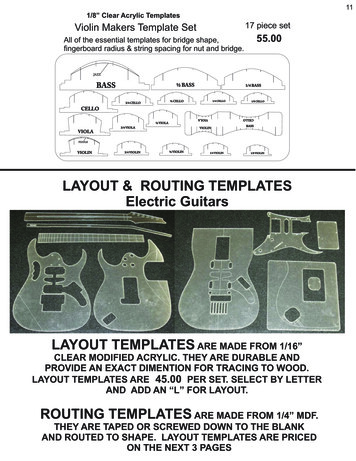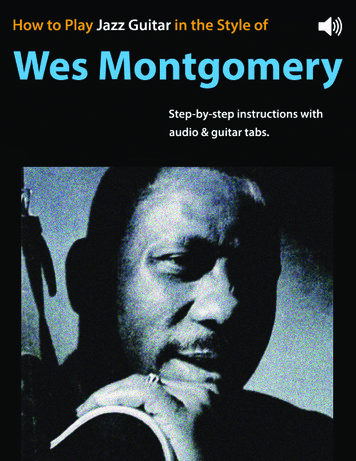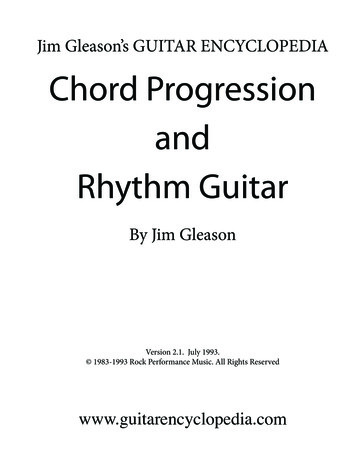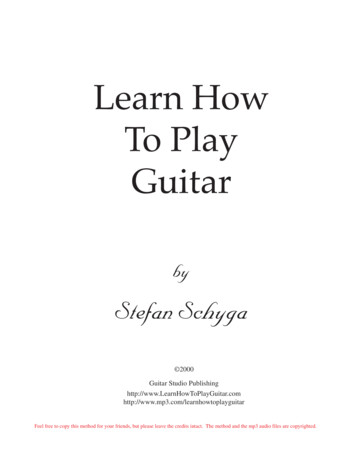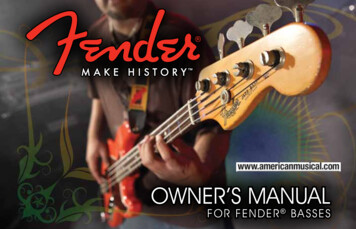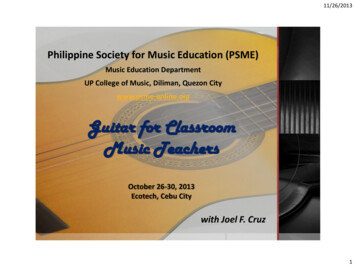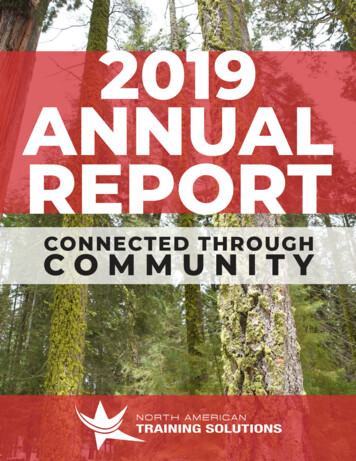
Transcription
T HE S CIENCE OF E LECTRIC G UITARS AND G UITAR E LECTRONICSRevision July 1, 2014
T HE S CIENCE OF E LECTRIC G UITARSAND G UITAR E LECTRONICSJarmo Lähdevaara
This is a revised edition of the published first edition (ISBN 978-952-286-420-8).This revised edition is available only in electronic format without a specific ISBN.Distribution as a pdf-file only from the website http://www.guitarscience.net.c 2012 – 2014 Jarmo Lähdevaara
PreludeThis is a book about travelling. It describes the life journey of a ˇ “( which is set freeby plucking a string of an electric guitar. On its fascinating trip towards feelingthe freedom of the outside world, our little ˇ “( travels through pickups, wires,cables, effect devices and amplifiers, all the way down to the loudspeaker. Duringthis trip, ˇ “( faces a lot of difficult situations; it has to push through resistances,fight between the plates of capacitors and take a ride in the whirls of inductors.Luckily our little ˇ “( meets a lot of friends along the way. By the help of transistorsand electronic tubes, our little ˇ “( gains a lot of energy and at the end of the signalchain ˇ “( has grown large enough to set itself free into the surrounding air, feelingthe pressure changes and wind in its stem and eventually disappearing into thehorizon. And no one will ever hear about it again.This book is a collection of all the knowledge gained over the years of practising to play bass guitar. Somehow the technical side of things is sometimes moreappealing than the artistic side. After several years of studying in the field oftechnology, the author realised that everything learnt on the way can be thoughtabout the viewpoint of music and especially guitars. This way of thinking hashelped the author to learn many topics in engineering in practise by making aconcrete reference to the technology of music. Therefore, this book is a documentation of different topics in physics, music and engineering, all connected bythat one bass guitar.All the topics presented in this book are composed together from already knownfacts, which means that very little new information regarding the topics is produced. The thing that makes this book differ from other similar publications isthe view into the whole chain of scientific elements that guitar players are dealing with when playing their instrument. The primary motivation to document allthis information in the form of a book was to share the knowledge in one package, instead of having all the bits and pieces scattered around in several books,articles and the Internet. The ultimate goal in the writing process has been thatthe reader of this book could find answers to most of the fundamental questionswhich might arise from the technological point of view of electric guitars. Thev
vibook tries to answer questions like: What creates the tones that are heard fromstringed musical instruments? How scientific properties of a guitar string affectthe tone? How can basic components of electronics be used to modify tones?How different pickup types affect the tone? What is inside a guitar amplifier?How to achieve an electroacoustic transformation using loudspeakers? How areguitar effect pedals implemented? How does a guitar tuning device work?These questions are the ones that have been puzzling the author for a long time.Others possibly share the same questions, but have not yet managed to findsatisfying answers to them. This book tries to give an answer to these questions,and tries to form a complete picture of the complex signal chain that is formedby a guitar and all the accessories related to it. In addition to this, the book meltstogether two completely different branches of science. Hopefully, by the help ofthis book, a common language between physics and music will be found.The book is typeset using LATEX. All the pictures have been produced with gnuplotor MetaPost. Special thanks to John Hobbes for creating MetaPost and alsothanks to Gustavo S. Bustamante Argañaraz for preparing a MetaPost add-oncalled MakeCirc, which has been used to draw most of the circuit diagrams forthis book. In addition, MusiXTEX was used to create the musical notations, andOctave was used as a Matlab replacement for the numerical verification of symbolic results. All the software to support practical projects related to the topicsof this book was written in C language and compiled with the gcc compiler. Allthis artillery is running smoothly on the Linux XUbuntu laptop computer, whichgracefully served the author during the whole writing process.20.10.2012; Oulu, FinlandJ.L.The Science of Electric Guitars and Guitar Electronics; copyright c (2012 – 2014) Jarmo Lähdevaara
DisclaimerThis book contains a few complete circuit diagrams, which are suitable to bebuilt as do-it-yourself projects. While the circuits have been tested to be workingin practise and the circuit diagrams have been drawn with care, there may betypographical errors in the schematics, which in the worst case could cause thecircuit to malfunction. All the guitar effect devices presented in this book areintended to be powered by a regular 9 volt battery, which is safe to be used as apower source in almost any condition. For your own safety, never use any powersource that connects to the mains outlet.The guitar amplifier circuit diagrams analysed within the scope of this book donot add up into complete amplifiers because the analysis is presented only froma theoretical perspective. Guitar amplifiers would obviously require more than a9 volt battery as a power source, so it is highly advised not to try to build thoseas a home-made project unless you are an experienced electrician. When doingwiring work on the tone and volume control section in the guitar, please makesure that the guitar cable is not connected to the guitar. Under the bridge ofthe guitar there often is a grounding cable, which makes you part of the electriccircuit when touching the strings. In some short circuit conditions this mightlead to lethal accidents. For your own safety, never use any power source thatconnects to the mains, and keep the guitar well away from any mains outlet atall times.Although the text has been read through several times, certainly mistakes and errors, typographical and even conceptual ones, might be lurking within the paragraphs. The accuracy of the information presented within this book has not beeninspected by any other person than the author, and therefore the reader is advised to keep a sceptical attitude towards the contents of this book. The authoris to be accused for all the remaining mistakes and errors in the text.All trademarks used in this book, registered or otherwise, are the property oftheir respective owners. This applies to all manufacturer and product namesused when referring to commercially available amplifiers, effect devices, strings,cables and other related accessories.vii
viii
ContentsP RELUDE. . . . . . . . . . . . . . . . . . . . . . . . . . . . . . . . . . . . . . . .vD ISCLAIMER . . . . . . . . . . . . . . . . . . . . . . . . . . . . . . . . . . . . . . .vii1 I NTRO . . . . . . . . . . . . . . . . . . . . . . . . . . . . . . . . . . . . . . . .1.1 B ASIC CONCEPTS OF MUSIC . . . . . . . . . . . . . . . . . . . . . . . . . . .1.1.1 Interpreting notes . . . . . . . . . . . . . . . . . . . . . . . . . . .1.1.2 A connection to physics . . . . . . . . . . . . . . . . . . . . . . . .1.2 B ASIC CONCEPTS OF PHYSICS . . . . . . . . . . . . . . . . . . . . . . . . . .1.2.1 The differential vs. the derivative . . . . . . . . . . . . . . . . . . .1.2.2 The differential vs. the integral . . . . . . . . . . . . . . . . . . . .1.2.3 Continuous time vs. discrete time . . . . . . . . . . . . . . . . . . .1.2.4 Fourier analysis vs. an amplitude spectrum . . . . . . . . . . . . .1.2.5 The concept of a decibel vs. an amplitude spectrum . . . . . . . . .1.2.6 The Laplace transform vs. a transfer function . . . . . . . . . . . .1.3 B ASIC CONCEPTS OF ELECTRONICS . . . . . . . . . . . . . . . . . . . . . . .1.3.1 Current and voltage . . . . . . . . . . . . . . . . . . . . . . . . . .1.3.2 Elementary building blocks of electronics . . . . . . . . . . . . . .1.3.3 Properties of resistors . . . . . . . . . . . . . . . . . . . . . . . . .1.3.4 Properties of capacitors . . . . . . . . . . . . . . . . . . . . . . . .1.3.5 Properties of inductors . . . . . . . . . . . . . . . . . . . . . . . . .1.3.6 Circuit analysis methods . . . . . . . . . . . . . . . . . . . . . . . .1.3.7 Properties of semiconductors . . . . . . . . . . . . . . . . . . . . .1.3.8 Properties of transistors . . . . . . . . . . . . . . . . . . . . . . . .1.3.9 Transistor circuit DC analysis . . . . . . . . . . . . . . . . . . . . .1.3.10 Transistor circuit AC analysis . . . . . . . . . . . . . . . . . . . . .1.3.11 Input and output impedances . . . . . . . . . . . . . . . . . . . . .1.3.12 Circuit simulations with SPICE . . . . . . . . . . . . . . . . . . . .112466911132932393944444751556067707581822 V IBES . . . . . . . . . . . . . . . . . . . . . . . . . . . . . . . . . . . . . . . .2.1 A MATHEMATICAL MODEL OF A GUITAR STRING . . . . . . . . . . . . . . . .2.1.1 Setting up the coordinates . . . . . . . . . . . . . . . . . . . . . . .2.1.2 The ideal string model . . . . . . . . . . . . . . . . . . . . . . . . .2.1.3 Setting up the equations . . . . . . . . . . . . . . . . . . . . . . . .2.1.4 Solving the transverse wave equation . . . . . . . . . . . . . . . . .2.1.5 The significance of An : the amplitude spectrum . . . . . . . . . . .2.1.6 Alternative solutions of the wave equation . . . . . . . . . . . . . .2.2 N ONLINEAR EFFECTS IN STRING VIBRATION . . . . . . . . . . . . . . . . . .2.2.1 The effect of amplitude . . . . . . . . . . . . . . . . . . . . . . . .2.2.2 The effect of friction . . . . . . . . . . . . . . . . . . . . . . . . . .2.2.3 The effect of stiffness . . . . . . . . . . . . . . . . . . . . . . . . . .2.2.4 The effect of end supports . . . . . . . . . . . . . . . . . . . . . . .2.2.5 Coupling between directions of vibration . . . . . . . . . . . . . . .2.3 N ONLINEAR EQUATIONS OF MOTION . . . . . . . . . . . . . . . . . . . . . .2.4 M EASURING THE STRING VIBRATIONS . . . . . . . . . . . . . . . . . . . . .2.4.1 Properties of the measured string . . . . . . . . . . . . . . . . . . .898989919599106109111111114118123132140151152ix
xCONTENTS2.4.22.4.32.4.42.4.52.4.6The measurement setup . . . . . . . . . . . .Error limit calculations . . . . . . . . . . . . .Measurement results - Amplitude spectrum .Measurement results - Decay of upper partialsMeasurement results - Pitch glide . . . . . . .1521551571661703 G UITAR PICKUPS . . . . . . . . . . . . . . . . . . . . . . . . . . . . . . . . . . 1753.1 T HE EFFECT OF PICKUP POSITIONING . . . . . . . . . . . . . . . . . . . . . . 1753.2 M AGNETIC PICKUPS . . . . . . . . . . . . . . . . . . . . . . . . . . . . . . . 1773.2.1 The basic construction and function of a magnetic pickup . . . . . 1783.2.2 The magnetic field of a pickup magnet . . . . . . . . . . . . . . . . 1793.2.3 Magnetic interaction between a pickup and strings . . . . . . . . . 1843.2.4 Electromagnetic induction in a magnetic pickup . . . . . . . . . . . 1913.2.5 The magnetic field generated by the coil of a pickup . . . . . . . . 1973.2.6 A single-coil pickup vs. a humbucker . . . . . . . . . . . . . . . . . 1993.2.7 A magnetic pickup as part of an electric circuit . . . . . . . . . . . 2023.2.8 Measurements on a magnetic pickup . . . . . . . . . . . . . . . . . 2093.3 O PTICAL PICKUPS . . . . . . . . . . . . . . . . . . . . . . . . . . . . . . . . 2163.3.1 An optical transducer as a guitar pickup . . . . . . . . . . . . . . . 2173.3.2 An optical pickup as a signal source . . . . . . . . . . . . . . . . . . 2203.3.3 An optical pickup as part of an electric circuit . . . . . . . . . . . . 2263.3.4 Measurements on an optical pickup . . . . . . . . . . . . . . . . . . 2283.4 P IEZOELECTRIC PICKUPS . . . . . . . . . . . . . . . . . . . . . . . . . . . . 2323.4.1 The piezoelectric effect . . . . . . . . . . . . . . . . . . . . . . . . . 2333.4.2 A piezoelectric transducer as a signal source . . . . . . . . . . . . . 2343.4.3 A piezoelectric pickup as part of an electric circuit . . . . . . . . . . 2393.4.4 Measurements on a piezoelectric pickup . . . . . . . . . . . . . . . 2464 G UITAR TONE CONTROL CIRCUITS . . . . . . . . . . . . . . . . . . . . . . . . . 2514.1 A BASIC TONE CONTROL CIRCUIT . . . . . . . . . . . . . . . . . . . . . . . . 2514.2 M ODIFIED TONE CONTROL CIRCUITS . . . . . . . . . . . . . . . . . . . . . . 2574.3 T HE ’B IG M UFF π’ TONE CONTROL CIRCUIT . . . . . . . . . . . . . . . . . . 2624.4 A MPLIFIER TONE CONTROLS FOR GUITAR MOUNTING . . . . . . . . . . . . . 2665 G UITAR CABLES . . . . . . . . . . . . . . . . . . . . . . . . . . . . . . . . . . . 2715.1 T HE GENERAL TRANSMISSION LINE THEORY . . . . . . . . . . . . . . . . . . 2715.2 P RACTICAL GUITAR CABLES . . . . . . . . . . . . . . . . . . . . . . . . . . . 2765.2.1 A shielded instrument cable . . . . . . . . . . . . . . . . . . . . . . 2765.2.2 A parallel wire cable . . . . . . . . . . . . . . . . . . . . . . . . . . 2815.3 I MPEDANCE MATCHING . . . . . . . . . . . . . . . . . . . . . . . . . . . . . 2845.4 A CABLE AS PART OF A GUITAR TONE CONTROL CIRCUIT . . . . . . . . . . . . 2896 E FFECT DEVICES . . . . . . . . . . . . . . . . . . . . . . . . . . . . . . . . . . . 2936.1 A MPLITUDE EFFECTS . . . . . . . . . . . . . . . . . . . . . . . . . . . . . . 2946.2 F UZZ BOX VOODOO . . . . . . . . . . . . . . . . . . . . . . . . . . . . . . . 2956.2.1 The DC bias analysis of the fuzz effect . . . . . . . . . . . . . . . . 2976.2.2 The AC analysis of the fuzz effect . . . . . . . . . . . . . . . . . . . 3006.2.3 Side effect: feedback in transistor circuits . . . . . . . . . . . . . . 3036.2.4 A SPICE model for the fuzz circuit . . . . . . . . . . . . . . . . . . 3256.2.5 Results of simulations, calculations and measurements . . . . . . . 3356.3 T REMOLO AMPLITUDE MODULATION . . . . . . . . . . . . . . . . . . . . . 3426.3.1 The DC bias analysis of the tremolo effect . . . . . . . . . . . . . . 3466.3.2 The AC analysis of the tremolo effect . . . . . . . . . . . . . . . . . 347The Science of Electric Guitars and Guitar Electronics; copyright c (2012 – 2014) Jarmo Lähdevaara
xiCONTENTS6.3.3 Side effect: the JFET as a resistor . . . . . . . . . . . .6.3.4 Side effect: the RC phase-shift oscillator . . . . . . . .6.3.5 A SPICE model for the tremolo circuit . . . . . . . . .6.3.6 Results of simulations, calculations and measurements6.4 A COMPRESSOR AND AN EXPANDER . . . . . . . . . . . . . . . .6.5 F REQUENCY EFFECTS . . . . . . . . . . . . . . . . . . . . . . .6.6 T HE ORIGINS OF THE WAH -WAH SOUND . . . . . . . . . . . . .6.6.1 The DC analysis of the wah effect . . . . . . . . . . . .6.6.2 The AC analysis of the wah effect . . . . . . . . . . . .6.6.3 Side effect: RLC circuit resonance . . . . . . . . . . . .6.6.4 Side effect: the Miller theorem . . . . . . . . . . . . .6.6.5 A SPICE model for the wah circuit . . . . . . . . . . .6.6.6 Results of simulations, calculations and measurements6.7 A N OCTAVE DOUBLER EFFECT . . . . . . . . . . . . . . . . . . .6.7.1 The DC analysis of the Green Ringer effect . . . . . . .6.7.2 The AC analysis of the Green Ringer effect . . . . . . .6.7.3 A SPICE model for the Green Ringer circuit . . . . . .6.7.4 Results of simulations, calculations and measurements6.8 P HASE EFFECTS . . . . . . . . . . . . . . . . . . . . . . . . . .6.9 A PHASE SHIFTER . . . . . . . . . . . . . . . . . . . . . . . . .6.9.1 Side effect: the relaxation oscillator . . . . . . . . . .6.9.2 Side effect: an op-amp all-pass filter . . . . . . . . . .6.9.3 Side effect: the op-amp in the nodal matrix method . .6.9.4 The DC analysis of the Phase 45 effect . . . . . . . . .6.9.5 The AC analysis of the Phase 45 effect . . . . . . . . .6.9.6 A SPICE model for the Phase 45 circuit . . . . . . . . .6.9.7 Results of simulations, calculations and measurements6.10 A FLANGER . . . . . . . . . . . . . . . . . . . . . . . . . . . . .6.11 T IME EFFECTS . . . . . . . . . . . . . . . . . . . . . . . . . . .6.12 T HEORETICAL PITCH SHIFT . . . . . . . . . . . . . . . . . . . .6.13 A THEORETICAL REVERBERATION EFFECT . . . . . . . . . . . .6.14 A NALOGUE DELAY ACTUATORS . . . . . . . . . . . . . . . . . .6.15 A REVERBERATION EFFECT USING MECHANICAL SPRINGS . . . .6.15.1 Wave propagation in a helical spring . . . . . . . . . .6.15.2 Interfacing electrical and mechanical vibrations . . . .6.15.3 A drive and recovery circuit for a reverberation unit . .6.15.4 Measurements on the reverberation device . . . . . . 4554644684727 G UITAR AMPLIFIERS . . . . . . . . . . . . . . . . . . . . . . . . . . . . . . . . . 4797.1 C OMMON GUITAR AMPLIFIER BUILDING BLOCKS . . . . . . . . . . . . . . . . 4807.2 O PERATION MODE CLASSES OF AUDIO AMPLIFIERS . . . . . . . . . . . . . . . 4817.3 D ISTORTION IN AUDIO POWER AMPLIFIERS . . . . . . . . . . . . . . . . . . . 4837.4 T UBE AMPLIFIERS . . . . . . . . . . . . . . . . . . . . . . . . . . . . . . . . 4857.4.1 The anatomy of different tube types . . . . . . . . . . . . . . . . . 4867.4.2 A tube preamplifier . . . . . . . . . . . . . . . . . . . . . . . . . . . 4887.4.3 A tube amplifier tone control circuit . . . . . . . . . . . . . . . . . 4927.4.4 Tube phase splitters . . . . . . . . . . . . . . . . . . . . . . . . . . 4957.4.5 A tube power amplifier . . . . . . . . . . . . . . . . . . . . . . . . . 5037.5 T RANSISTOR AMPLIFIERS . . . . . . . . . . . . . . . . . . . . . . . . . . . . 5087.5.1 A solid-state preamplifier . . . . . . . . . . . . . . . . . . . . . . . 5097.5.2 A solid-state power amplifier . . . . . . . . . . . . . . . . . . . . . 5137.6 I NTERFACING AMPLIFIERS WITH LOUDSPEAKERS . . . . . . . . . . . . . . . . 519The Science of Electric Guitars and Guitar Electronics; copyright c (2012 – 2014) Jarmo Lähdevaara
7.7 G UITARAMPLIFIER SIMULATIONS WITHSPICE. . . . . . . . . . . . . . . . 5208 L OUDSPEAKERS . . . . . . . . . . . . . . . . . . . . . . . . . . . . . . . . . . . 5278.1 T HE CONSTRUCTION OF A MOVING - COIL LOUDSPEAKER ELEMENT . . . . . . 5278.2 M ODELLING THE VOICE COIL . . . . . . . . . . . . . . . . . . . . . . . . . . 5308.3 E LECTROMECHANICAL ANALOGUES REVISITED . . . . . . . . . . . . . . . . . 5328.4 A N ELECTRICAL MODEL OF THE DRIVER . . . . . . . . . . . . . . . . . . . . 5388.5 M EASURING THE ESSENTIAL DRIVER PARAMETERS . . . . . . . . . . . . . . . 5449 T UNING DEVICES . . . . . . . . . . . . . . . . . . . . . . . . . . . . . . . . . . 5499.1 S TATE VARIABLE BIQUAD FILTERS . . . . . . . . . . . . . . . . . . . . . . . . 5509.2 A MONOSTABLE MULTIVIBRATOR . . . . . . . . . . . . . . . . . . . . . . . . 5589.3 A N ANALOGUE GUITAR TUNING DEVICE . . . . . . . . . . . . . . . . . . . . . 5619.4 M EASUREMENTS ON THE TUNING CIRCUIT . . . . . . . . . . . . . . . . . . . 5709.5 T HE S TROBOTUNER . . . . . . . . . . . . . . . . . . . . . . . . . . . . . . . 5769.6 AUTOMATIC TUNING SYSTEMS FOR GUITARS . . . . . . . . . . . . . . . . . . 58010 O UTRO . . . . . . . . . . . . . . . . . . . . . . . . . . . . . . . . . . . . . . . . 583R EFERENCES . . . . . . . . . . . . . . . . . . . . . . . . . . . . . . . . . . . . . . 589N OMENCLATURE. . . . . . . . . . . . . . . . . . . . . . . . . . . . . . . . . . . . 593A BBREVIATIONS . . . . . . . . . . . . . . . . . . . . . . . . . . . . . . . . . . . . . 598A PPENDIX A . . . . . . . . . . . . . . . . . . . . . . . . . . . . . . . . . . . . . . . 599A PPENDIX B . . . . . . . . . . . . . . . . . . . . . . . . . . . . . . . . . . . . . . . 601A PPENDIX C . . . . . . . . . . . . . . . . . . . . . . . . . . . . . . . . . . . . . . . 605A PPENDIX D . . . . . . . . . . . . . . . . . . . . . . . . . . . . . . . . . . . . . . . 613A PPENDIX E . . . . . . . . . . . . . . . . . . . . . . . . . . . . . . . . . . . . . . . 615xii
Chapter1IntroThis first chapter covers some basic ideas on the languages of music, physics andelectronics, including the most relevant theoretical background on the topics discussed in this book. This introductory chapter is intended as a quick referencesection extending the rest of the chapters, although it does not form a completeand uniform coverage of all topics. In some cases the theoretical treatment ispresented from the viewpoint of the author and should not be taken as the absolutely correct view. It is advisable to read the material with a critical mindset.1.1Basic concepts of musicThere are several different theories on the science of music. Different locationsof the world have their own view on musical notations, tunings and scales. Theso-called mainstream music is considered to be composed in "the West", meaningmainly the countries of Europe and America [1, p. 230]. Therefore, the musicalideologies described in this book follow the theories of Western music. Thisis justified from the viewpoint of a guitar player, since the guitar is commonlyconsidered a Western instrument. By focusing mainly on Western music, one isrestricted to examining only the properties of the twelve-tone equal temperamentscale [1, p. 231], a concept that will be explained later.Musical masterpieces are documented using a distinct language, a notation, whichonly professional musicians understand. By representing a song by writing noteson a staff, a musician can document every sound and tone to be reproduced withcorrect timings and distinct tonal embellishments by other musicians. To fullyunderstand the topics covered in this book, some terms and symbols from themusical vocabulary need to be explained.1
2INTRO1.1.1Interpreting notesThe sound of music is composed from three principal elements. The first of theseelements is pitch, which indicates the relative highness or lowness of a sound.The second element is duration, i.e. the relative length of a sound, and the thirdprincipal element is loudness, which refers to the intensity or strength of a sound[2, p. 1]. These three basic elements are mapped into musical notations asdescribed in Figure 1.1.I44ˇ 4ˇ 2ˇˇˇ 6ˇE2 F2 G2 A2 B2 C3H 44 ˇˇ( ˇ) ˇ*G4Figure 1.1: Musical notations of pitch and durationThe notes are written into a space limited by five horizontal lines called a staff.In Figure 1.1 the staff has been divided to left and right sides. On the left sideare the most usual notations that define the pitch of the sound, whereas the rightside gives some examples on the notation related to duration. Let’s explore theleft side first.The extracted notation starts with a clef symbol. There are a few different kindsof clef symbols; the one used here is a bass clef, a.k.a. the F clef symbol. It automatically assigns fixed note names to the five staff lines. Notes are generallynamed with capital letters, e.g. A, B, C, E, F and G, although there are nationaldifferences in the note naming conventions. Here we will use namings introduced in American music literature; for example, as seen in reference [2]. Thedifferent octaves of these notes are expressed using subscript numbering, e.g. A1and A2 . This kind of note naming system gives a concrete meaning for the different pitches of notes. The bass clef starts from the note named as E2 , representingthe sound of the lowest open string of a guitar. Surprisingly, the bass guitar’s lowE-string actually has the note E1 . This small conflict is discussed a little later.The location of a note on a certain staff line is not enough to accurately depictall possible pitches. In addition there are specific notations for small pitch modifications. The notation of is used to lower the pitch of a note by a semitone andthe notation of is used to raise the pitch of a note by a semitone. The notationof is used to return the normal pitch to a note which has been modified earlierusing or . The concept of semitone is explained in section 1.1.2.The Science of Electric Guitars and Guitar Electronics; copyright c (2012 – 2014) Jarmo Lähdevaara
31.1 BASIC CONCEPTS OF MUSICOn the right side of Figure 1.1 is a collection of usual notations of duration. Firstthere is a treble clef symbol, which is the most common of all clef symbols. This isfollowed by a meter signature, which is used to indicate the rhythmic ordering ofnotes of different duration in the staff. Then, keeping the pitch constant, notes ofdifferent duration are shown. Starting from the whole note, its duration fills one4full bar when using the most common meter signature. The following notes4are derived from the whole note by dividing the duration of the previous noteby a factor of two: half note, quarter note, eighth note, sixteenth note and 32ndnote. [2, pp. 2–11]In addition to these notations of duration, a general tempo can be set to fix acertain duration for a specific note such as a quarter note, e.g. ˇ “ 80. This alsosets the other notes’ durations relative to the tempo setting of the quarter note.As already mentioned, different clef symbols are used to assign written music tocertain instruments. The most common division done with clefs is to use the bassclef for low tone instruments and the treble clef for the rest of the instruments.However, this is not a good method to indicate the actual pitches of notes, sincethe pitch variation of different instruments is much larger than can be writtenusing normal bass and treble clefs. Of course an additional written notificationcan be used to indicate a certain instrument, but from a scientific point of viewthe pitch is not well defined in these cases. Figure 1.2 tries to explain the actualpitch ranges that can be written using the most common clef symbols.GăIˇ(E2ˇ(C3ˇC4ˇ(C4ˇ(A4ˇ-G5Figure 1.2: The boundary between the bass clef and the treble clefThe use of clefs automatically affects the pitches of the notes written on the staff.Noting from Figure 1.2, the C4 note acts as a median value between the bass andthe treble clefs. Approaching music from a more scientific point of view, one canask the question: how are different instruments mapped to the bass clef and thetreble clef? The thickest string of a bass guitar vibrates as E1 . How to writemusic for the bass guitar since there are not enough staff lines available? Thesame question can also be assigned to the guitar, which lowest string vibrates asThe Science of Electric Guitars and Guitar Electronics; copyright c (2012 – 2014) Jarmo Lähdevaara
4INTROE2 . Should guitar notes be written on the bass clef? Sometimes it is just clearfrom the context that notes to be played by bass are written on the normal bassclef and the instrument name is assigned as bass. But if there is a need to useexact notations, then one would write music for bass as:Iˇˇ ˇ ˇ ııı 8va bassoE1 F1 G1 A1 B1 C2 D2 E2 F2Figure 1.3: Scaling the staff to the actual pitch of the instrumentThe same procedure should be applied to guitar notes when using the trebleclef. There are similar definitions for raising the actual pitch defined by a certainclef symbol. These definitions and the proper way of using them are describedthoroughly in reference [2].1.1.2A connection to physicsGeneral scientific definition of sound describes sound waves as pressure fluctuations [3, p. 528]. Also from scientific perspective, pitch is related to frequency,duration is related to time and loudness relates to energy [2, p. 1]. When considering pitch as a scientific quantity, it is a somewhat naive simplification to saythat pitch equals frequency, since in the musical world pitch is seen through thesensation of a heard sound [4, pp. 1–11].Even when playing the same note, different instruments create a different sensation of sound, which is described to have a certain timbre, tone colour [2, p. 1] ortone quality [5, p. 18]. Physics explains timbre as a sum of several frequencies,where the lowest (fundamental) frequency defines the actual pitch for the sound,but one still cannot equalise the sums of frequencies and the sensation of hearinga sound. The first treatment ever to combine physics and music was published bythe great German scientist Hermann Helmholtz back in the year 1862 [5]. Thispublication also refers to the sensations of tone, as a direct implication from thetitle of the book. Therefore, it is not all that simple to give an exact definition forsound, tones and music purely based on the theories provided by physics.On the other hand, it is acceptable to say that every written note has a certainfrequency (a.k.a. pitch). These frequencies obey a certain logical constructionthat can be used to calculate specific frequencies for all notes in relation to someThe Science of Electric Guitars and Guitar Electronics; copyright c (2012 – 2014) Jarmo Lähdevaara
51.1 BASIC CONCEPTS OF MUSICother note for which the frequency is already known.The frequencies of harmonic upper partials (often misleadingly called overtones)of a note are integer multiples of the fundamental frequency [5, p. 22]. Thisseries of upper partials also covers all octaves of a note because octaves are2n (n some positive integer) multiples of the fundamental frequency. In atypical guitar tuning scheme, the proceeding 12 frets from a certain note coverthe whole octave. Moving one fret upwards or downwards from a note equalsa change of a half tone (semitone) in the pitch. Hence, it is possible to derivea geometric series equation for the dependencies between different notes
age, instead of having all the bits and pieces scattered around in several books, articles and the Internet. The ultimate goal in the writing process has been that the reader of this book could find answers to most of the fundamental questions which might arise from t
